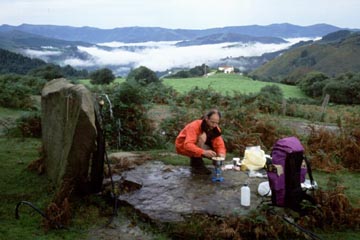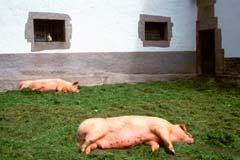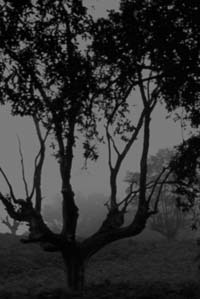In detail ...
The early morning found me in fretful sleep, worrying about some wild creature rattling our pots and pans as it looked for scraps. Then I awoke with a start, I had been dreaming and the sound was that of a distant cattle bell. Karen reported a teaching dream, seeded by the high irresponsibility of leaving behind classroom duties. Up and out! today we must cross the frontier and arrive at Arizkun in Spain, the first village on the trek, where we might find temptation for bored palates.
With an improved packing routine we soon emerged from our hide-away to regain the ridge top proper which defines Col de Nabarlatsa (475m); then to dive into a tree filled gully on the south side. The way out of this was obvious enough for beasts of some kind had trodden countless prints deep into the mire, each one now water-filled. We skipped, slithered and leapt our way through this sloppy quagmire to arrive in a farmyard. From there the sleeping culprits were evident spragged out on a barn floor; the day too early for these fat porkers and no sign of the farmer yet either. Just beyond the farmhouse we found oursleves without re-assurance of GR11
balisage and were forced to retrace steps; the missing marker was located on a low stone obscured by bracken.
The first hill of the day was looming ahead but 'breakfast rock' intervened; a pair of perpendicular sandstone monoliths, the upright one presenting a handy tap. A room with a view, only four walls short! The green vista beyond was just warming in the early sun as we burned the porridge; what sacrilage! We had only a few days worth of oats, and little hope of finding them again en route. Hunger triumphed and made light of the error, but helped not a jot when it came to the tedious clean-up, compounded by the tap's idiosyncrasies; not so handy after all. It gushed and 'swizzled' by turns, alternating between clear and murky water and was not easily shut off.
The way led upwards through ghostly quiet beech pollards before rounding the hill Zentinel where we noted a shepherds cabane, useful for a bivouac. Easy tracks led us on past a slumbering German trekker who was as surprised to see us, as we him. 'Aha, some competition' I thought. He was soon on his feet, pursuing us up Atxuela mountain which afforded fine but hazy views from its 800m summit ridge. Too easy to keep right on walking, we found ouselves descending to the south; the right direction for the German who was following the GR11 to Elizondo, but we must back-track to find the side-spur Arburu, dotted with roaming horses. We were grateful to have a hunter confirm our course for Arizkun.
The Buzzard
French: 'Buze Variable'. Before the great vultures dominate in the higher mountains, the buzzard tops the avian food chain; unlike the vultures however, buzzards do not wait for carrion, they kill creatures as large as rabbits or grouse. In fact there are about six species to be found in the Pyrenees, and though easily distinguished from eagles, falcons, harriers and kites, are not so readily seperable within themselves. They are more vocal than eagles and vultures; the plaintive 'mewing' call will often alert presence before they are seen.
Our passage down the southeast oriented spur brought a fresh outlook over a green valley dominated by Auza mountain (1304m) beyond and just north of tomorrow's stage;
higher hills, we noted. On the north side of the spur we wound down through an impressive stand of ancient beech pollards;
Voici!
broad trunks which had once benefitted from regular harvest were now succumbing to a top-heavy crown and some had toppled. As if neglect were not enough, some had suffered the threat of fire in their hollow trunks, with a girth large enough to stand 20 men. Lower down, the steep track must have been driven by the conferring hunters whose rugged vehicle stood by. Beyond the track's verge of yellow gorse and purple heather the tiny hamlet of Apaoia appealed with its red roofs and white walled homes.
Voici!
Our way led just to the north of that, through Azpilkueta which presented more lazing pigs; no wonder these creatures get so fat!
Karen surprised some local farmers here with her fluent Spanish; they directed us to progress across the valley avoiding tarmac, which was
obligatoire after the river. We greeted the river as an old friend, the Bidassoa, first met in the Hendaye suburbs, and significant as the one and only Spanish river on our journey to flow back into the Atlantic. A small ascent brought us into Arizkun which presented gardens full of vegetables, action on the
fronton court, and at least two shops which tempted us inside. We soon collected carrots, tomatoes, peppers, bread and cheese for the evening meal.
It was not at this point clear where we would stay, but we decided to eat right there on the low walls of the village
plaza. Ample room for two to spread out food and rucsac contents. The earlier cloud cover had melted before the evening sun which now shone hotly, and we were glad to cast off boots and sweaty socks before settling to our meal. The village folk were also gathering now at the end of a working day. A small herd of lumbering milkers trudged by with swinging udders, dogs and children played on the green, and then came a hen with chicks; they were halfway across the road when a jeep approached, pulling up just in time, but parting the brood with two chicks stranded on the far side. Anxious moments for the mother and onlookers, ended as the family unit was restored, to forage the grassy square at our backs.
Then the really hard part of the day arrived; having relaxed and eaten, we must re-pack and exit en-route uphill to find a wild camping site. Not at all Karen's notion of the right thing to do, despite my assurance that tomorrow would be shorter as a result.
Karen_comments
It was a steep track with quite a few ambiguites which eventually brought us to a hanging copse of gaunt pollards, way above the village. There we pitched and were installed, long before the storm arrived. We had had some good sound sleep before the rumbling thunder startled us into consciousness, and the night was white-lightened. Then came torrential rain, by turns drumming on our nylon igloo and merging into erratic 'drip-dripping' from off the trees; broken sleep only returned slowly after this rowdy interlude.



